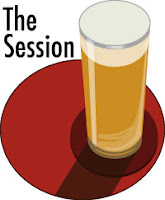 I had an interesting conversation with a brewer at a recent beer festival about bottle sizes. He pointed out that in the UK there's a tendency for breweries to use bottle size as an indicator of which side of the craft divide they sit. I can't say I'd noticed, but having run a few examples in my head, I now see what he means: 330ml shows you're young and hip and craft, whereas a half litre leaves you open to the accusation of being a fuddy-duddy family-owned provider of boring brown bitter. As a home drinker and a pint man, I'm very glad that this worrying trend hasn't really caught on here. But today I'm exploring some British beer from very much the "craft" side of the house, all sold 330ml at a time. As it happens, it's also Session day and our subject is Cans or Bottles, so I'm including both formats and may even throw in the odd observation on their respective merits. But back to craft beer as applies to British brewing...
I had an interesting conversation with a brewer at a recent beer festival about bottle sizes. He pointed out that in the UK there's a tendency for breweries to use bottle size as an indicator of which side of the craft divide they sit. I can't say I'd noticed, but having run a few examples in my head, I now see what he means: 330ml shows you're young and hip and craft, whereas a half litre leaves you open to the accusation of being a fuddy-duddy family-owned provider of boring brown bitter. As a home drinker and a pint man, I'm very glad that this worrying trend hasn't really caught on here. But today I'm exploring some British beer from very much the "craft" side of the house, all sold 330ml at a time. As it happens, it's also Session day and our subject is Cans or Bottles, so I'm including both formats and may even throw in the odd observation on their respective merits. But back to craft beer as applies to British brewing... The archetypal self-declared UK craft brewery is BrewDog and they had embraced the 330 even when they were still brewing cask ale and writing their best-befores in biro. Nowadays they're big enough to send random bloggers free beer, like this here bottle of Bourbon Baby which arrived in the post a while back. As the name suggests, it's barrel aged but of a modest strength: just 5.9% ABV. Cola-coloured with a cream-toned head, it does have the spicy vanilla scent of bourbon, but enticingly so, and not overpowering. The base beer is a sweet and toffeeish scotch ale and that's still just about detectable in the taste, but the woody whisky dominates the flavour completely. I'm used to the roundness you get in stronger, darker bourbon-aged beers and this is showing me why they're made that way: there's a thinness at this beer's core which doesn't do it any favours. If you love the taste of bourbon in beers, and don't mind it being there for its own sake, then this is for you. Seekers of a more integrated beer experience need not apply, however.
The archetypal self-declared UK craft brewery is BrewDog and they had embraced the 330 even when they were still brewing cask ale and writing their best-befores in biro. Nowadays they're big enough to send random bloggers free beer, like this here bottle of Bourbon Baby which arrived in the post a while back. As the name suggests, it's barrel aged but of a modest strength: just 5.9% ABV. Cola-coloured with a cream-toned head, it does have the spicy vanilla scent of bourbon, but enticingly so, and not overpowering. The base beer is a sweet and toffeeish scotch ale and that's still just about detectable in the taste, but the woody whisky dominates the flavour completely. I'm used to the roundness you get in stronger, darker bourbon-aged beers and this is showing me why they're made that way: there's a thinness at this beer's core which doesn't do it any favours. If you love the taste of bourbon in beers, and don't mind it being there for its own sake, then this is for you. Seekers of a more integrated beer experience need not apply, however. Siren is a brewery whose beers I've only ever encountered on draught before, so this bottle of Undercurrent oatmeal pale ale is the first I've ever had in the house. I'm a frequent ranter against the bottle conditioning of small-pack hoppy beers and this is a definite offender: murky orange to begin with and then a surprise extra swish of yeasty goo going in accidentally at the end. Arrgh! At 4.5% ABV that's bound to have detrimental effect on the hops. But I don't think it did. Undercurrent has a simple but lovely aroma of oranges and grapefruit while the flavour screams freshness: piney resins, juicy mandarins, sweet tinned peaches and a pinch of gunpowder spicing. It's a session-strength hop tour-de-force (though quite possibly a waste of oatmeal) but I'd still like a pint of it. At a recent focus group for a new Irish beer brand I said some very rude things about the test version of their pale ale. Standard-setting beers like Undercurrent are the reason why.
Siren is a brewery whose beers I've only ever encountered on draught before, so this bottle of Undercurrent oatmeal pale ale is the first I've ever had in the house. I'm a frequent ranter against the bottle conditioning of small-pack hoppy beers and this is a definite offender: murky orange to begin with and then a surprise extra swish of yeasty goo going in accidentally at the end. Arrgh! At 4.5% ABV that's bound to have detrimental effect on the hops. But I don't think it did. Undercurrent has a simple but lovely aroma of oranges and grapefruit while the flavour screams freshness: piney resins, juicy mandarins, sweet tinned peaches and a pinch of gunpowder spicing. It's a session-strength hop tour-de-force (though quite possibly a waste of oatmeal) but I'd still like a pint of it. At a recent focus group for a new Irish beer brand I said some very rude things about the test version of their pale ale. Standard-setting beers like Undercurrent are the reason why. So I was totally stoked facing into Broken Dream "breakfast stout". It's not so spectacular, however, being a damn decent but rather plain thick, strong stout of 6.5% ABV. There's lots of roast, or possibly even generous amounts of burnt; dry overall with a streak of very dark chocolate to lighten the mood. Usually, breweries of Siren's calibre toss in a dash of fruit or flowers, but that's all absent here, more's the pity. I'll need to look elsewhere for that sort of action.
So I was totally stoked facing into Broken Dream "breakfast stout". It's not so spectacular, however, being a damn decent but rather plain thick, strong stout of 6.5% ABV. There's lots of roast, or possibly even generous amounts of burnt; dry overall with a streak of very dark chocolate to lighten the mood. Usually, breweries of Siren's calibre toss in a dash of fruit or flowers, but that's all absent here, more's the pity. I'll need to look elsewhere for that sort of action. And here it is, in the aluminium overcoat of Beavertown's Holy Cowbell stout. Once again the yeast gets the better of me as overenthusiastic pouring dumps some beige lumps from the bottom of the can into my otherwise flawless black beer. But yet again the beer gods smile down upon me because there's nothing that can interfere with this beer's greatness. The exotic fruit aromas entice, Bisto-style, from three rooms away and the flavour is a punchy mix of bitter veg leaves, fleshy tropical fruit and invigorating bath salts. Whereas something this strong and dark normally departs from the palate on its bitterer aspects, it's the sumptuous juicy fruit that's the parting shot here which makes the beer very moreish indeed. It's only slightly weaker than the first beer of this post but packs so much more in.
And here it is, in the aluminium overcoat of Beavertown's Holy Cowbell stout. Once again the yeast gets the better of me as overenthusiastic pouring dumps some beige lumps from the bottom of the can into my otherwise flawless black beer. But yet again the beer gods smile down upon me because there's nothing that can interfere with this beer's greatness. The exotic fruit aromas entice, Bisto-style, from three rooms away and the flavour is a punchy mix of bitter veg leaves, fleshy tropical fruit and invigorating bath salts. Whereas something this strong and dark normally departs from the palate on its bitterer aspects, it's the sumptuous juicy fruit that's the parting shot here which makes the beer very moreish indeed. It's only slightly weaker than the first beer of this post but packs so much more in.Is it the packaging format that makes Holy Cowbell so amazing? No, I don't think so. It's spectacular on draught too, for one thing. I'll admit I like the practicalities of canned beer: the robustness and stackability, and the speed at which they chill. But I also respect the opinion of those fusty half-litre merchants at Thornbridge when they say the case for quality is unproven. For the moment I'm not fussed what a brewery puts its beer in, as long as what comes out is the grade of Undercurrent and Holy Cowbell.





Unless it's a particularly strong beer, or something weird and Belgian, I just can't get my head round a 330ml bottle being a proper drink. Plus you always seem to pay more per fluid ounce.
ReplyDeleteNot when you get it for free, you don't. Wahey! Blogging roolz!
DeleteSome of this will be the influence of the US market, where the standard size for "a beer" is 12 US fl oz (355 ml) rather than an Imperial pint, & bottles follow suit. I wonder if there's a European influence too - or do European sub-6% beers come in 500 ml bottles rather than 330? (I was thinking back to my last trip to Belgium, but then realised I hardly drank anything that was under 6%.)
ReplyDeleteI paid £4 for a tin of Holy Cowbell in a pub in south Wimbledon.If it had been a more expensive 500ml bottle I wouldn't have bothered and would have missed a superb beer.cheers
ReplyDeleteYou make me thirsty. Especially that yeast in the stout...
ReplyDeleteThanks for contributing to The Session!
Thanks for participating. Here's the roundup: http://microbrewr.com/session-98-roundup-cans-or-bottles/
ReplyDelete